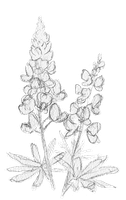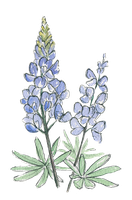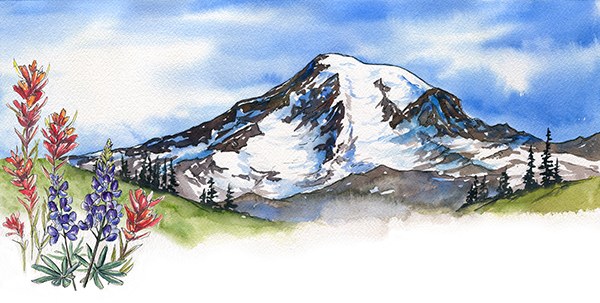
You are cobalt blue mixed with just a little bit of rose. And you are my yellow straight out of the palette, no mixing required! What is your name, little friend? Ohhh, and you are scarlet and ultramarine blue with a hint of white.
As an artist and outdoor painter, the wildflowers of spring and summer are a joyous conversation told in the language of rioting color, delicate lines, and careful observation. When I am hiking, I entertain myself on the trail by trying to identify all the flowers I see and imagining the mixtures of paint I will use to illustrate their many hues. Often, I’m so distracted by the flowers that I trip over a rocky step or slide on a lingering snowfield while my nose follows the smell of lupine in the mountain breeze.
Wildflowers are magical and ephemeral. I love learning about them and their alpine homes before heading out for hikes. And, as an environmental artist, I follow the wildflowers for their beauty and for the story they tell of our warming world.
From the celebration of the first buds of spring to the stampedes of people who travel to witness meadows brimming with blooms, wildflowers are part of the vast ecological cycles driven by the seasons. These cyclic patterns are studied by a branch of science called phenology, which explores the connections between climate and the timing of annual natural events like wildflower blooms, animal migrations, and many other phenomena over time.
I first learned how phenology told the story of climate change while hiking in the Alps with scientists from the Research Center for Alpine Ecosystems in Chamonix, France (CREA Mont Blanc). The researchers showed me ponds full of tadpoles beneath snow-capped peaks. The baby frogs were hatching earlier as snow melted faster, and the ponds sat beside meadows full of wildflowers that were seen blooming earlier and appearing at higher elevations on the mountains.
Now, when I hike at home in Washington, I paint the flowers and take note of when I see them to increase my awareness of how my favorite alpine meadows are changing over time. Knowing about these patterns makes the blooms even more precious and beautiful to witness.
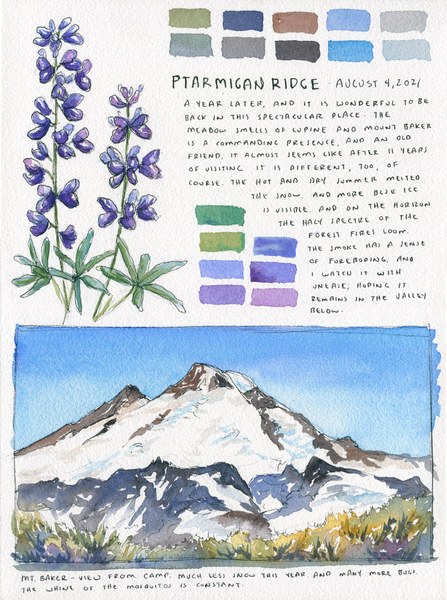
Claire’s tips for enjoying wildflower season
You don’t need to be an expert botanist or even an amateur flower lover to enjoy our alpine wildflowers. Opportunities abound! Mount Rainier, Mount Saint Helens, and the Teanaway Mountains are all home to incredible alpine meadows, many easily accessible. Here are my favorite tricks for enjoying wildflower season:
- Before you go, get a guidebook. Make it a goal to learn a few types of flowers you might see. Identifying flowers enriches my understanding of the landscape and is a fun game to play with friends and kids.
- Arrive at popular trails early, and go on days when the weather is bad. While I can’t always paint in a soaking mist, I do love how the flowers look with beads of water amplifying and reflecting their colors. The trails are also much less crowded on grey or rainy days, so I can really take my time to see the flowers.
- If you’re stopping to photograph, paint, or otherwise enjoy the flowers, don’t step on them! Or any other green happy growing things off the trail for that matter, as those green things will likely make more flowers if they aren’t squished by excited hikers. Alpine environments are really fragile (think of how many months the plants survive under the snow) and we can support them by staying on-trail. And, of course, don’t pick the flowers either.
- Stop at every amazing group of flowers and whoop with joy and encourage your group to admire them.
In Washington you can get involved in citizen science projects that collect data on flowers and other species. MeadoWatch is based at Mount Rainier and monitors flowers, and you can also look for marmots in the Olympics and butterflies in the North Cascades and Rainier with the Butterfly Project. Washington Trails Association (WTA) also has great articles on flowers, and the trip reports are a fantastic resource for monitoring when and where flowers appear.
How to sketch a wildflower
Sketching or painting while on a wildflower adventure requires a bit of planning before you go. Be sure to bring a writing tool, sketchbook, and some paint. I also plan to be out for an extra hour, so I bring more food, a few more layers, and a sit pad.
Once I’m hiking, I find a non-vegetated trailside pull-out to sit for a few minutes (or sometimes a few hours!) to draw some flowers. I love how much I learn by spending time carefully looking at each new flower I find.
Take your time. Really look at the flowers and the environment around them. Notice what kind of soil or rock they grow in. What kind of plants surround them? What do you see, smell, and hear? Write down your observations – and any questions! – alongside your sketches or in a notebook.
Step 1:
Start with a quick pencil sketch to define the basic arrangement of the flowers. I try to break each flower into the simplest shapes (for example, a single lupine flower is often a group of overlapping ovals).
Step 2:
Add ink and the first layer of watercolor paint. I like to work fast, so I try to paint with as few layers as possible to minimize drying time.
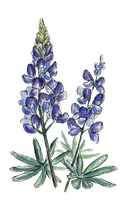
Step 3:
Add the second layer of paint and identify details like dots, stripes, or additional colors. I also focus on painting shadows on each petal to heighten the feeling of depth.
Claire Giordano is an environmental artist, writer, and teacher following the interwoven patterns of people, place, and climate change. See more of her work at claireswanderings.com and learn to paint with her at adventureartacademy.com.
This article originally appeared in our Spring 2022 issue of Mountaineer Magazine. To view the original article in magazine form and read more stories from our publication, visit our magazine archive.
All art by Claire Giordano.
Add a comment
Log in to add comments.So glad this beautiful article was posted online so as to add exposure to it. I really enjoyed the quality of the write-up, the artistry, the tips as well as the knowledge that Claire Giordano shared with us. As Mountaineers we are lucky to enjoy such diversity of interests. Thank you.
 Claire Giordano
Claire Giordano
